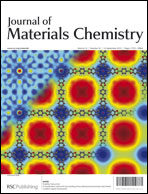Construction of glycoprotein multilayers using the layer-by-layer assembly technique
Abstract
A novel glycoprotein film was assembled from pig gastric mucin and poly(acrylamide-co-3-acrylamidophenylboronic acid) using a layer-by-layer technique, driven by the formation of boronate ester bonds between the boronic acid units and the polyols. The assembly was monitored by quartz crystal microbalance and UV-vis spectroscopy. The film thickness is increased with increasing the ionic strength and the pH of assembly solutions. Furthermore, the dynamic response of the assembled film to the presence of glucose was monitored in real time using quartz crystal microbalance with dissipation. Glucose competes with pig gastric mucin to bind with the boronic acid units in the multilayer film, resulting in its disassembly, and the disassembly rate is a function of the glucose concentration. The film is also sensitive to glucose at physiological conditions, albeit the response is weaker and slower than that at higher pH. This glucose-sensitive glycoprotein multilayer film can therefore be applied in glucose sensing and self-regulated insulin release systems.


 Please wait while we load your content...
Please wait while we load your content...